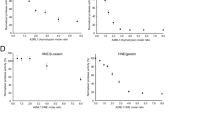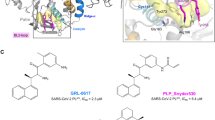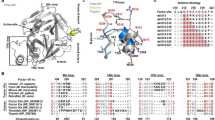Abstract
The three–dimensional structure of an uncleaved serpin, a variant of human antichymotrypsin engineered to be an inhibitor of human neutrophil elastase, has been determined by X–ray crystallographic methods and is currently being refined at 2.5 Å resolution. It contains an intact reactive loop in a distorted helical conformation. A comparison of the current model with that of its cleaved counterpart suggests that the conformational ‘stress’ of the serpin in its uncleaved and uncomplexed state may not be confined solely to the reactive loop or β–sheet A. It is intriguing that strand s4A is not pre–inserted into β–sheet A of the native serpin, and this has profound implications for the mechanism of serpin function.
This is a preview of subscription content, access via your institution
Access options
Subscribe to this journal
Receive 12 print issues and online access
$189.00 per year
only $15.75 per issue
Buy this article
- Purchase on Springer Link
- Instant access to full article PDF
Prices may be subject to local taxes which are calculated during checkout
Similar content being viewed by others
References
Travis, J. & Salvesen, G.S. Human plasma proteinase inhibitors. Ann. Rev. Blochem. 52, 655–709 (1983).
Huber, R. & Carrell, R.W. Implications of the three-dimensional structure of α1-antitrypsin for structure and function of serpins. Biochemistry 28, 8951–8966 (1989).
Bock, S.C. Structures and models of native serpins. Prot. Engng. 4. 107–108 (1990).
Bode, W. & Huber, R. Ligand binding: proteinase-protein inhibitor interactions. Curr. Opin. struct. Biol. 1, 45–52 (1991).
Banzon, J.A. & Kelly, J.W. β-Sheet rearrangements: serpins and beyond. Prot. Engng. 5, 113–115 (1992).
Crowther, D.C., Evans, D.L.I. & Carrell, R.W. Serpins: implications of a mobile reactive centre. Curr. Opin. Biotech 3, 399–407 (1992).
Rubin, H. The biology and biochemistry of antichymotrypsin and its potential role as a therapeutic agent. Biol. Chem. Hoppe-Seyler 373, 497–502(1992).
Matheson, N.R., van Halbeek, H. & Travis, J. Evidence for a tetrahedral intermediate complex during serpin-proteinase interactions. J. biol. Chem. 266, 13489–13491 (1991).
Loebermann, H., Tokuoka, R., Deisenhofer, J. & Huber, R. Human α1-proteinase inhibitor: crystal structure analysis of two crystal modifications, molecular model, and preliminary analysis of the implications for function. J. molec. Biol. 177, 531–556(1984).
Baumann, U. et al. Crystal structure of cleaved human α1-antichymotrypsin at 2.7 Å resolution and its comparison with other serpins. J. molec. Biol. 218, 595–606 (1991).
Mourey, L. et al. Crystal structure of cleaved bovine antithrombin III at 3.2 Å resolution. J. molec. Biol. 232, 223–241 (1993).
Baumann, U., Bode, W., Huber, R., Travis, J. & Potempa, J. Crystal structure of cleaved equine leucocyte elastase inhibitor determined at 1.95 Å resolution. J. molec. Biol. 226, 1207–1218 (1992).
Schecter, I. & Berger, A. On the size of the active site in proteases. I. Papain. Biochem. Biophys. Res. Commun. 27, 157–162 (1967).
Pemberton, P.A., Stein, P.E., Pepys, M.B., Potter, J.M. & Carrell, R.W. Hormone binding globulins undergo serpin conformational change in inflammation. Nature 336, 257–258 (1988).
Wright, H.T., Qian, H.X. & Huber, R. Crystal structure of plakalbumin, a proteolytically nicked form of ovalbumin. Its relationship to the structure of cleaved α1-proteinase inhibitor. J. molec. Biol. 213, 513–528 (1990).
Stein, P.E. et al. Crystal structure of ovalbumin as a model for the reactive centre of serpins. Nature 347, 99–102 (1990).
Stein, P.E., Leslie, A.G.W., Finch, J.T. & Carrell, R.W. Crystal structure of uncleaved ovalbumin at 1.95 Å resolution. J. molec. Biol. 221, 941–959 (1991).
Mottonen, J. et al. Structural basis of latency in plasminogen activator inhibitor-1. Nature 355, 270–273 (1992).
Schreuder, H.A. et al. The intact and cleaved human antithrombin III complex as a model for serpin-proteinase interactions. Nature struct. Biol. 1, 48–54 (1994).
Carrell, R.W., Stein, P.E., Fermi, G. & Wardell, M.R. Biological implications of a 3 Å structure of dimeric antithrombin. Structure (in the press).
Laskowski, Jr., M. & Kato, I. Protein inhibitors of proteinases. A. Rev. Biochem. 49, 593–626 (1980).
Hubbard, S.J., Campbell, S.F. & Thornton, J.M. Molecular recognition. Conformational analysis of limited proteolytic sites and serine proteinase protein inhibitors. J. molec. Biol. 220, 507–530 (1991).
Skriver, K. et al. Substrate properties of C1 inhibitor Ma (alanine 434→glutamic Acid). Genetic and structural evidence suggesting that the P12-region contains critical determinants of serine protease inhibitor/ substrate status. J. biol. Chem. 266, 9216–9221 (1991).
Cooperman, B.S. et al. Antichymotrypsin interaction with chymotrypsin: partitioning of the complex. J. biol. Chem. 268, 23616–23625 (1993).
Barlow, D.J. & Thornton, J.M. Helix geometry in proteins. J. molec. Biol. 201, 601–619 (1988).
Björk, I., Nordling, K. & Olson, S.T. Immunologic evidence for insertion of the reactive-bond loop of antithrombin into the A β-sheet of the inhibitor during trapping of target proteinases. Biochemistry. 32, 6501–6505 (1993).
Schulze, A.J., Huber, R., Degryse, E., Speck, D. & Bischoff, R. Inhibitory activity and conformational transition of α1-proteinase inhibitor variants. Eur. J. Biochem. 202, 1147–1155 (1991).
Schulze, A.J., Frohnert, P.W., Engh, R.A. & Huber, R. Evidence for the extent of insertion of the active site loop of intact α1-proteinase inhibitor in β-sheet A. Biochemistry. 31, 7560–7565 (1992).
Gettins, P. & Harten, B. Properties of thrombin- and elastase-modified human antithrombin III. Biochemistry 27, 3634–3639 (1988).
Bruch, M., Weiss, V. & Engel, J. Plasma serine proteinase inhibitors (serpins) exhibit major conformational changes and a large increase in conformational stability upon cleavage at their reactive sites. J. biol. Chem. 263, 16626–16630 (1988).
Carrell, R.W. & Owen, M.C. Plakalbumin, of α1-antitrypsin, antithrombin, and the mechanism of inflammatory thrombosis. Nature 317, 730–732(1985).
Perkins, S.J. et al. Secondary structure changes stabilize the reactive-centre cleaved form of SERPINs. A study by 1H nuclear magnetic resonance and Fourier transform infrared spectroscopy. J. molec. Biol. 228, 1235–1254 (1992).
Fujinaga, M. et al. Crystal and molecular structures of the complex of α-chymotryspin with its inhibitor turkey ovomucoid third domain at 1.8 Å resolution. J. molec. Biol. 195, 397–418 (1987).
Rühlmann, A., Kukla, D., Schwager, P., Bartels, K. & Huber, R. Structure of the complex formed by bovine trypsin and bovine pancreatic trypsin inhibitor. J. molec. Biol. 77, 417–436 (1973).
Bode, W., Papamokos, E., Musil, D., Seemueller, U. & Fritz, H. Refined 1.2 Å crystal structure of the complex formed between subtilisin Carlsberg and the inhibitor eglin c. Molecular structure of eglin and its detailed interaction with subtilisin. EMBO J. 5, 813–818 (1986).
McPhalen, C.A., Svendsen, I., Jonassen, I. & James, M.N.G. Crystal and molecular structure of chymotrypsin inhibitor 2 from barley seeds in complex with subtilisin Novo. Proc. natn. Acad. Sci. U.S.A. 82, 7242–7246 (1985).
Greenblatt, H.M., Ryan, C.A. & James, M.N.G. Structure of the complex of Streptomyces griseus proteinase B and polypeptide chymotrypsin inhibitor-1 from Russet Burbank potato tubers at 2.1 Å resolution. J. molec. Biol. 205, 201–228. (1989).
Fish, W.W. & Björk, I. Release of a two-chain form of antithrombin III from the antithrombin-thrombin complex. Eur. J. Biochem. 101, 31–38 (1979).
Rubin, H. et al. Cloning, expression, purification, and biological activity of recombinant native and variant α1-antichymotrypsin. J. biol. Chem. 265, 1199–1207 (1990).
Patston, P.A., Gettins, P., Beechem, J. & Schapira, M. Mechanism of serpin action: evidence that C1-inhibitor functions as a suicide substrate. Biochemistry 30, 8876–8882 (1991).
Schechter, N.M. et al. Reaction of human chymase with reactive-site variants of α1-antichymotrypsin — modulation of inhibitor versus substrate properties. J. biol. Chem. 268, 23626–23633 (1993).
Gettins, P. Absence of large-scale conformational change upon limited proteolysis of ovalbumin, the prototypic serpin. J. biol. Chem. 264, 3781–3785 (1989).
Stein, P.E., Tewkesbury, D.A. & Carrell, R.W. Ovalbumin and angiotensinogen lack serpin S→R conformational change. Biochem. J. 262, 103–107 (1989).
Katz, D.S. et al. Crystallization and atomic resolution x-ray diffraction analysis of antichymotrypsin variants. Biochem. biophys. Res. Commun. 196, 752–757 (1993).
Rosenfeld, M.A. et al. Adenovirus-mediated transfer of a recombinant α1-antitrypsin gene to the lung epithelium in vivo. Science 252, 431–434 (1991).
Wei, A., Rubin, H., Cooperman, B.S., Schechter, N. & Christianson, D.W. Crystallization, activity assay, and preliminary x-ray diffraction analysis of the uncleaved form of the serpin antichymotrypsin. J. molec. Biol. 226, 273–276 (1992).
Brünger, A.T., Kuriyan, J. & Karplus, M. Crystallographic R factor refinement by molecular dynamics. Science 235, 458–460 (1987).
Katz, D.S. & Christianson, D.W. Modeling the uncleaved serpin antichymotrypsin and its chymotrypsin complex. Prot. Engng. 6, 701–709 (1993).
Rossmann, M.G. & Blow, D.M. The detection of sub-units within the Crystallographic asymmetric unit. Acta. crystallogr. 15, 24–31 (1962).
Huber, R. Die automatisierte faltmolekülmethode. Acta. crystallogr. 19, 353–356 (1965).
Brünger, A.T. Extension of molecular replacement: a new search strategy based on Patterson correlation refinement. Acta. crystallogr. A46, 46–57 (1990).
Jones, T.A. Diffraction methods for biological macromolecules. Interactive computer graphics: FRODO. Methods Enzym. 115, 157–171 (1985).
Laskowski, R.A., MacArthur, M.W., Moss, D.S. & Thornton, J.M. PROCHECK: a program to check the stereochemical quality of protein structures. J. appl. Crystallogr. 26, 283–291 (1993).
Brünger, A.T. Free R value: a novel statistical quantity for assessing the accuracy of crystal structures. Nature 355, 472–475 (1992).
Bernstein, F.C. et al. The protein data bank: a computer-based archival file for macromolecular structures. J. molec. Biol. 112, 535–542 (1977).
Author information
Authors and Affiliations
Rights and permissions
About this article
Cite this article
Wei, A., Rubin, H., Cooperman, B. et al. Crystal structure of an uncleaved serpin reveals the conformation of an inhibitory reactive loop. Nat Struct Mol Biol 1, 251–258 (1994). https://doi.org/10.1038/nsb0494-251
Received:
Accepted:
Issue Date:
DOI: https://doi.org/10.1038/nsb0494-251
This article is cited by
-
Reactive centre loop dynamics and serpin specificity
Scientific Reports (2019)
-
Structural insights into serpin—protease complexes reveal the inhibitory mechanism of serpins
Nature Structural & Molecular Biology (1997)
-
Arginine substitutions in the hinge region of antichymotrypsin affect serpin β-sheet rearrangement
Nature Structural & Molecular Biology (1996)
-
Serine protease inhibitors (SERPINS): Where mechanism meets medicine
Nature Medicine (1996)
-
Inhibitory conformation of the reactive loop of α1-antitrypsin
Nature Structural & Molecular Biology (1996)



